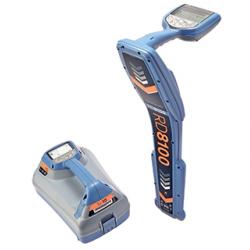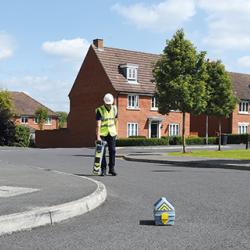Finding Underground Cables and Pipes
Reducing damage to underground cables and pipes
Digging holes in the ground is a fundamental part of construction and of the installation and maintenance of buried utilities. Unfortunately, every time ground is broken there is the risk of damaging buried services. Damage can be both expensive and dangerous and can also seriously impact companies’ reputations. Being able to excavate safely is a fundamental competence for utility companies, their contractors and the construction industry. Fortunately, there is a range of well-established techniques that can be used to find buried pipes and cables, and reduce these risks cost-effectively.
It's a big problem…
In the USA, there were 379,000 strikes in 2016 (Common Ground Alliance 2016), the United Kingdom sees around 60,000 strikes each year (Institute of Civil Engineers). Excavation in both the UK and the US is highly-regulated so rates of damage are likely to be higher in regions with less regulation. The mega-trend of increasing urbanization across the world means that there will be more cables and pipes in the ground and more frequent excavation. Damage to underground assets is a large problem with the potential to become more serious unless the correct steps are taken.
… with some serious consequences
Damaging underground utilities can be dangerous: news reports across the world describe serious injury or death to workers and bystanders that can result from striking buried electricity cables or gas pipelines. Damage is also expensive: the utility will have to be repaired, productivity will be reduced, reputations are weakened and compensation paid. In many countries, injury at work can result in criminal prosecution and large fines. Insurance companies will look at damage rates as they assess premiums. In some countries, the average cost of cable strikes can exceed $25,000 per event.
What to do?
Damage happens for four main reasons:
- Proper notification to 811 “call before you dig” wasn’t made and no detection tools are used
- Not using the best tools available
- Working practices are not adequate or are not understood
- On-site behaviors do not correctly reflect desired working practices
Fortunately, there are simple solutions for each of these problems that have been adopted by customers across the world.
Call 811 prior to any excavation
Each state has a local 811 center that can dispatch locators to your proposed excavation site prior to work starting.
For more information visit: http://call811.com/
Use detection tools prior to, and during excavation
This is the simplest, and most important step. Don’t excavate before calling 811, and until the area has been scanned and marked-up by trained people using reliable location tools. Use tools in conjunction with maps (where available) to verify the marks and scan for buried services that may not have been marked correctly, or at all, but never rely on maps alone.
There are two main approaches to finding buried services with electromagnetic locators: precision locate and avoidance/post-locate. For precision locate, Radiodetection’s 8100 locator series are designed for use by professional utility locators and survey professionals; they offer a much broader choice of modes and frequencies for the precise identification of individual services.
The CGA Best Practices, section 5.10, recommends that: “Prior to excavation, excavators verify that they are at the correct location, verify locate markings and, to the best of their ability, check for unmarked facilities. See more at: http://commongroundalliance.com/best-practices/best-practices-guide/510-locate-verification.
For the avoidance, or post-locate approach, Radiodetection’s CAT and Genny tools (C.A.T4 and Genny4) provide easy-to-use but powerful tools to locate buried services. They are targeted at excavation teams for them to use as part of their excavation and post-locate process.
No matter which approach is taken, it is vital that locators are used with matching signal transmitters e.g. Radiodetection’s Genny4 or TX-10 transmitters. The correct use of transmitters allows straightforward location of cables that are otherwise very difficult to find.
Use the best available technology
Use the best technology you can to detect buried services. Choose products that have been designed with the user in mind and which have modern features to make locating easier. For example, high accuracy and sensitivity, protection against interference from strong nearby power sources, selectable or multi-frequency signals, and warnings to the user for common incorrect use patterns.
Implement good working practices and training
The CGA Best Practices are the definitive guide for excavation safety and damage prevention. They should be followed during all relevant stages of a planned excavation.
For more information visit: http://commongroundalliance.com/programs/best-practices
Radiodetection further recommends that each company establish reliable and repeatable locating methods such as the locating checklist to ensure best practices are followed.
Effective training in safe working and in underground location is extremely important. Training can be vendor-delivered, in-house or externally-provided. Whichever route is chosen, they must be experts in the tools you have chosen and the practicalities of underground cable and pipe location. Training can be supplemented by material on vendors’ websites and by instructional videos.
Change on-site behaviors
Even when the above elements are in place, they will not be effective unless the tools are actually used, and used correctly, and procedures are properly followed. Radiodetection’s locators support customers in this task by recording what is done with our RD7100 and RD8100 precision locators and our C.A.T4 tools. This data-logging functionality records key locator parameters every second and stores the logs in on-board non-volatile memory. Stored data includes the mode, frequency, signal strength, the sensitivity setting of the locator, the depth of the located service and many more parameters.
With the data that is logged, supervisors can check if locators were used, if they were used correctly, and assess the compliance to procedure. For GPS-enabled locators, the location where the locate was performed can also be retrieved. This information can then be used to identify training or process improvement needs.
The future
Radiodetection are rolling out a new on-line logging and analysis product – C.A.T Manager Online. For users of our gC.A.T product – our avoidance tool with in-built GPS – C.A.T Manager Online provides an interactive cloud-based portal with a near real-time view of their fleet of locators. The data from each locator is uploaded to the cloud where it can be visualized and analyzed to measure compliance and further reduce utility damage and harm.
C.A.T Manager Online – although only available in certain countries currently – is proving to be successful with customers experiencing a significant reduction in utility strikes with some reporting up to a 50% improvement. C.A.T Manage Online aims to support organizations seeking to encourage safe working and reduce cable strikes.
Summary
Damaging underground pipes and cables when excavating is a serious and expensive problem of growing importance. By focusing on four key straightforward steps, companies can significantly reduce the risk of damage and harm:
- Call 811 and follow CGA Best Practices
- Use the best cable detection tools
- Develop excellent working procedures and ensure that people are trained
- Change on-site behaviors by effective supervision and monitoring
This will allow best-practice to be driven into the business and will help reduce utility strikes.
For more information, contact your local Radiodetection sales office or visit www.radiodetection.com.
References
Common Ground Alliance. 2016. Annual DIRT Report. Arlington, VA: Common Ground Alliance.
Common Ground Alliance. Best Practices v14.0
HSG47. 2014. Avoiding danger from underground services. London: UK Health & Safety Executive. http://www.hse.gov.uk/pubns/priced/hsg47.pdf.


